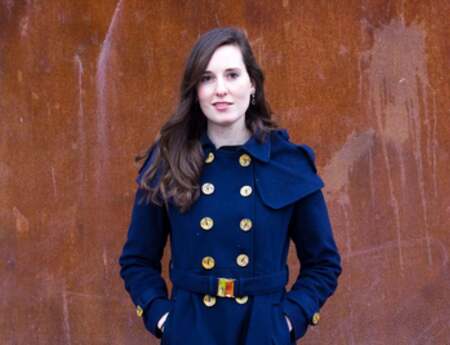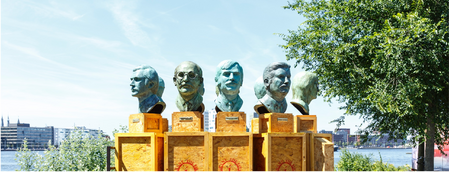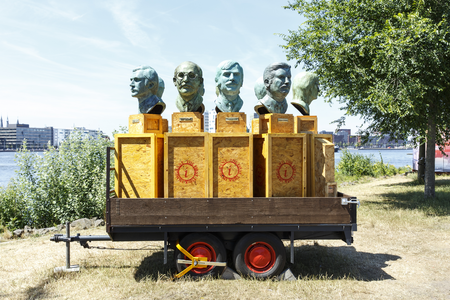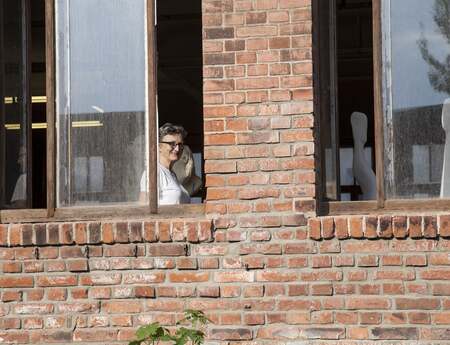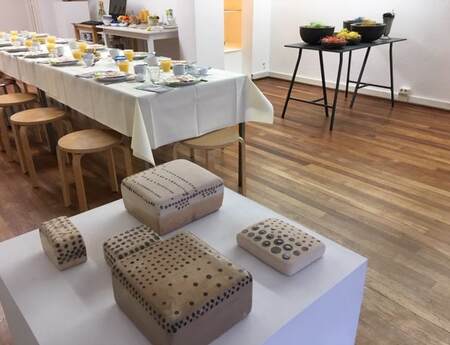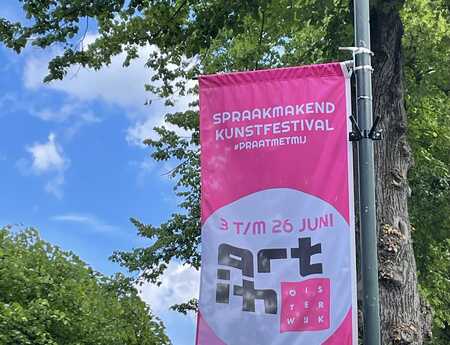Moving sculptures and their hidden meanings: A traveling monument holding stories of migration
“May Your Dreams Come True” reads one of the banners young people are carrying as they cycle through the streets of Amsterdam Noord following a cart carrying large bronze sculptures in the late summer of 2018. The parade ends in the neighboorhood the Molenwijk, in front of the brand new Framer Framed workshop. This relocation of the artwork "The First Turk Immigrant or The Nameless Heroes of The Revolution" by the Turkish artist Suat Ögüt (1986) offers a whole plater of symbolism.
First of all, this mobile artwork in the public space informed residents of the Molenwijk the art institution Framer Framed had arrived. Before, the artwork was displayed all summer on the IJ-promenade, near the Tolhuistuin, where Framer Framed used to be located. Instead of luring the Northerners to the banks of the new trendy IJ, Framer Framed decided to bring artists and art to the people living in the north of the city by moving into the Molenwijk.
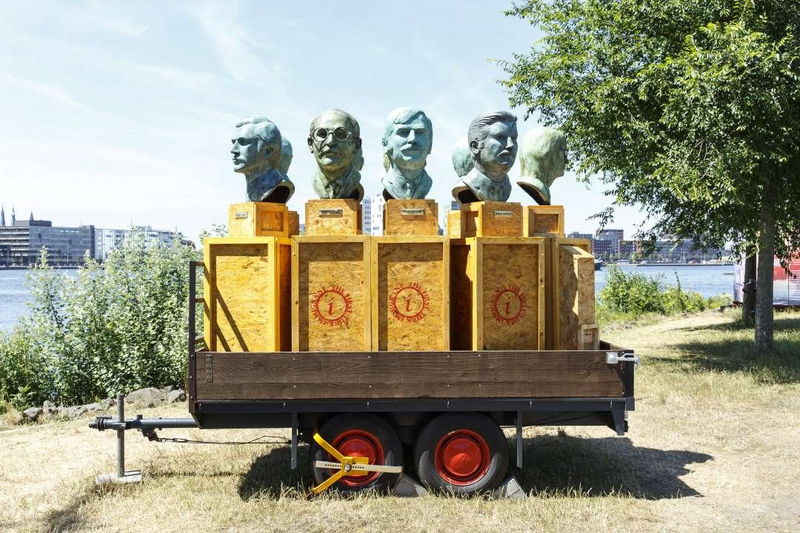
But this work of art on wheels was much more then a calling card, because secondly the stories of Turkish immigrants are told. The sculptures on the cart are portraits of political refugees from the 1960s to the 1980s, who were persecuted by the Turkish government. “In 2012, I met Doğan Özgüden, a journalist and key figure for this project,” says Ögüt. “He gave me a lot of insight into the stories of political refugees. He has written interesting books about his childhood in the 1940s to the present, and tells how things were before he left for Europe.”
Through archival research, Ögüt found nine people, each of whom had fled to a different European country. These countries (Austria, Belgium, Denmark, France, Germany, the Netherlands, Sweden, Switzerland and the United Kingdom) had agreements with the Turkish government about admitting migrant workers. Therefore, at the time no distinction was made between economic and political immigrants. “Everything is based on perception and is put away under the heading of 'migration'. I think that's problematic,” says Ögüt. “There are several reasons to be here. These are not popular people and their stories are largely unknown. They have battled for certain things. These activists are fighting for their rights. Not just in Turkey, but for anyone classified as an ‘immigrant’ in Europe. That is why I hope this monument also amplifies the voices of others.”
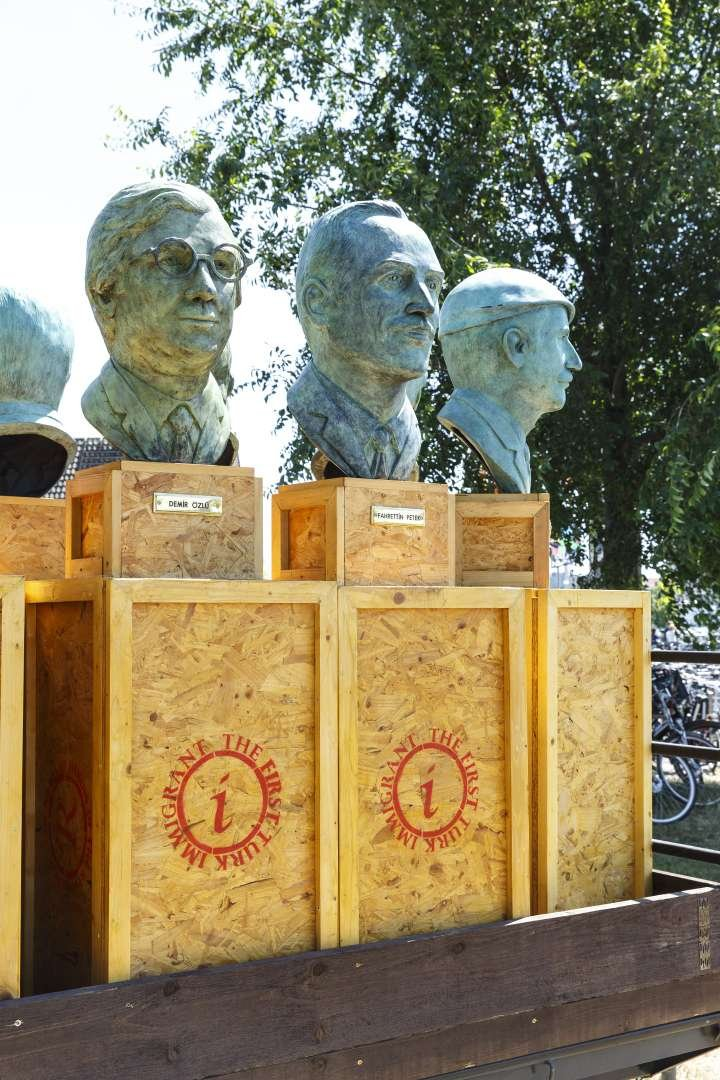
Ögüt made these people tangible with his sculptures. He based their portraits on the photographs he found in archives from the time they fled Turkey. “They were still young people, between twenty-five and thirty years old when they left” explains Ögüt. Among the portraits of men, there was only one that depicted a woman: Şengül Köker. “It wasn’t my intention, but I couldn’t find many female activists who had moved from Turkey at the time. For the presentation of this work on the IJ-promenade during the exhibition Songs of the Unsung (2018), the emphasis was on her. Köker even came here from Switzerland especially for the opening. Also, the first presentation in Werkplaats Molenwijk revolved around her.”
The parade with banners from the IJ-promenade to the Molenwijk was also based on Köker's life. “She has been a member of many political parties and she still is politically active. She was responsible for making the banners for various demonstrations. So I collected those banners from her personal archive,” says Ögüt. “My work for that first exhibition in the Molenwijk was also based on the banners, which were mainly made of bedding. It’s such an everyday object. So I used them in their original function, which is as bed sheets. You could then listen to Köker's stories on the bed. I used the slogans on the banners with students in the procession to the Molenwijk.”
The mobile monument of Ögüt consists of more than just statues. For each bust you could take an envelope from the cart, in which the story of the person portrayed is described. “My intention was not only to show art, but also to communicate something through the stories that were in the envelopes.” A discourse was created. “People, mainly Turkish, approached me through social media. I met up with some of them. They wanted to know more about the work and about me. Of course, many people have only taken the letter and nothing else. But when it's personal, people take action and that's happened a few times. Yesterday I made an appointment with a friend, whom I got to know through one of my works in the Amsterdam Museum. These chance encounters through work and connection are very valuable.” In the end, Ögüt distributed 250.000 letters during the summer months in which the artwork was displayed on the busy IJ-promenade.
The location was an important element of the work for another reason, because the Turkish community used to live near the Tolhuistuin in the 1960s and 70s. “When the Eye Museum came here, things changed very quickly. The immigrants we’re pushed further and further away to places such as the Molenwijk. Due to gentrification, the people who now walk on the IJ-promenade are completely different. Everything is becoming commercial and it’s not fair to the people who have to move.”
Ögüt admits he is not sure whether his artwork was understood in the Molenwijk. “There is a large population of immigrants there,” says Ögüt. “It was the first time Framer Framed did something with Werkplaats Molenwijk, so everyone was still trying to understand how things work. I would rather perceive this artwork as a visual representation of Framer Framed's arrival,” explains Ögüt.
In addition to Framer Framed's move to the Molenwijk, this mobile work of art shows the precarious position of immigrants in Europe and how people can’t take root anywhere due to gentrification. “By making the work mobile, it can be moved at any time.” But Ögüt also points to a positive symbolism: “These people are active. As a result, they travel a lot to get together and continue to build things. With this monument I show this attitude of the people portrayed by visually bringing them together.”
Finally, Ögüt also uses Turkish traditions from the Ottoman Empire and Ataturk era and inserts them into the contemporary public space of Amsterdam. By casting heroes in bronze Ögüt shows giving people a monument and pulling them out of the concepts and abstractions of bureaucracy into the public sphere, can add a lot of weight. Not just to the artwork, but the people the sculptures portray. It has the potential to reshape society.

